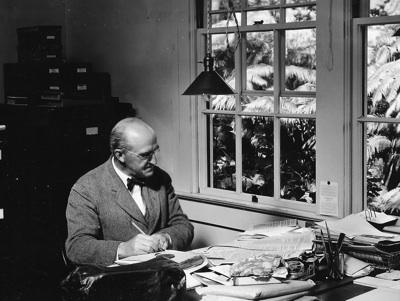For a century now researchers have been studying volcanic activity from the Hawaiian Volcano Observatory, a facility that has provided many insights into volcanoes and earthquakes in the Pacific.
The observatory's story will be told on January 17th at 7 p.m. at the After Dark in the Park program at Hawai‘i Volcanoes National Park.
U.S. Geological Survey Hawaiian Volcano Observatory Scientist-in-Charge Jim Kauahikaua will talk about the founding of the observatory in January 1912, as well as HVO’s achievements monitoring Hawaiian volcanoes and earthquakes during the past century. His presentation will be held at the park’s Kīlauea Visitor Center Auditorium. Park entrance fees apply.
The founding of HVO, America’s first volcano observatory, is attributed to Thomas A. Jaggar in the year 1912. But the study and monitoring of Kīlauea actually began in 1911 with Frank Perret, who came to Hawai‘i at the request of Jaggar.
Mr. Jaggar arrived at Kīlauea on Jan. 17, 1912, and immediately set forth monitoring earthquakes and changes in the shape of Kīlauea with the best tools available to him at the time: a few seismometers, some meteorological equipment, and a surveyor’s transit.
One hundred years later, HVO scientists in 2012 analyze data collected from more than 100 field stations, each of which consists of one to five instruments, including seismic, deformation, volcanic-gas, geologic, and other monitoring tools. These stations transmit data to HVO around the clock, with a single instrument sending as much as 60 terabytes of data each year—more information than Jaggar could have imagined possible.
"Volcanoes are an important part of life on Hawai‘i Island, and all of us who live here must learn to live safely within the dynamics of an ever-changing volcanic environment," said Mr. Kauahikaua. "Part of this celebration is recognizing the tremendous advances we've seen in the methods, tools, and technology used to study Hawaiian volcanoes and how that has helped lead to a remarkable increase in our understanding of how volcanoes work."
"The HVO helps ensure the safety and welfare of citizens of our island by forecasting potential destructive volcanic activity," said Quince Mento, former Administrator, Hawai‘i County Civil Defense Agency. "Without the HVO's dedicated staff our public safety agencies would not be able to mitigate loss of life and property in a timely fashion. We celebrate HVO's 100th anniversary and its continued role in protecting our island residents and advancing the science of volcanology."
Lava first erupted above sea level more than 500,000 years ago to begin forming the Island of Hawai‘i. Since then, countless eruptions from its five volcanoes have built the "Big Island" to a towering height of more than 4,000 m (13,000 ft).
Hawai‘i's two most active volcanoes — Mauna Loa and Kilauea — erupt lava frequently enough to pose a serious hazard to property on many parts of the island. About 40 percent of Mauna Loa, the most massive volcano on Earth, has been covered by lava in the past 1,000 years, and over 90 percent of Kilauea's surface is covered by lava less than 1,100 years old.
The current eruption of Kilauea has been ongoing since 1983, and HVO staff members have been dedicated to helping keep people safe. In 1990, for example, lava flows threatened the town of Kalapana. During this difficult period, HVO scientists provided detailed information 7 days a week on lava movement to the Hawai‘i County Civil Defense, which made decisions regarding evacuation, road closures, and safe vantage points for residents and visitors.
As land development expands toward areas of relatively high volcanic hazard, the threat to life and property on Hawai‘i will increase accordingly.
"Volcanic activity and its associated earthquakes are responsible for Hawai‘i's fertile soil, rainfall, isolated habitat for unique species, breathtaking natural beauty, but also, unfortunately, its geologic hazards," said Marcia McNutt, USGS Director.
Mr. Kauahikaua will tell the story of HVO’s first 100 years, the various buildings and locations HVO has occupied, the legacy of HVO’s leaders, the evolution of volcano monitoring tools and techniques, and significant discoveries along the way.
HVO’s entire history is a lot of information to compress into a 45-minute presentation, but Mr. Kauahikaua says not to worry. He is coauthor of a new USGS General Interest Product, The Story of the Hawaiian Volcano Observatory—A Remarkable First 100 Years of Tracking Eruptions and Earthquakes.” One hundred paper copies of the publication will be distributed on a first-come, first-served basis to attendees at his talk.
The public is also invited to attend an Open House of the observatory in celebration of HVO’s centennial milestone.
“HVO is not ordinarily open to the public, so our Open House on Jan. 21 is a special opportunity for island residents and visitors to see how we monitor Hawaiian volcanoes and to interact with HVO scientists,” said Kauahikaua.
Mr. Kauahikaua’s presentation is one of many programs offered by HVO during Volcano awareness Month and in celebration of HVO’s 100th anniversary in January 2012. For details about this After Dark in the Park program, please call 808-985-6011. More information about Volcano Awareness Month is posted on the HVO website at hvo.wr.usgs.gov


 Support Essential Coverage of Essential Places
Support Essential Coverage of Essential Places






